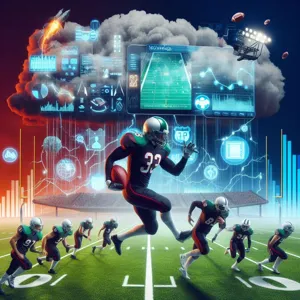In the high-stakes world of American football, where every second counts and every play can alter the course of a game, the role of officiating has never been more critical.
The introduction of instant replay technology has dramatically transformed how games are officiated, creating a revolution that enhances the accuracy and fairness of the sport. Gone are the days when a questionable call could define a team’s season; now, every pivotal moment can be revisited and scrutinized with the precision of modern technology. In this blog post, we will explore the evolution of instant replay in American football, examining its impact on the game, the challenges it presents, and how it continues to shape the future of officiating. Join us as we delve into this groundbreaking shift that not only redefines the rules of the game but also reinforces the integrity of one of America’s favorite pastimes.
1. Introduction to the Instant Replay System

In the fast-paced world of American football, where split-second decisions can determine the outcome of a game, the introduction of the Instant Replay System marks a transformative leap in officiating. Officially implemented in the NFL in 1986, this system was designed to enhance the accuracy and fairness of calls made on the field, ensuring that the integrity of the game is upheld. With the ability to review controversial plays, the Instant Replay System serves as a safeguard against human error, providing referees with the opportunity to reassess crucial moments that could sway the game’s momentum.
At its core, the Instant Replay System utilizes advanced technology, including multiple camera angles and slow-motion footage, enabling officials to scrutinize plays from various perspectives. This ensures that critical decisions, such as touchdowns, turnovers, and penalties, are made with the utmost precision. The system has evolved over the years, incorporating real-time feedback and allowing for quicker reviews, which helps maintain the game’s pace while also enhancing the viewing experience for fans.
Moreover, the implementation of this system has sparked discussions about the balance between human judgment and technological assistance in sports officiating. As teams and players adapt to the presence of instant replay, strategies are reshaped, and the psychological dynamics of the game shift. Fans, too, have embraced this evolution, often finding themselves on the edge of their seats as they await the official call after a replay review.
As we delve deeper into the intricacies of the Instant Replay System, we’ll explore its impact on gameplay, its technological advancements, and the ongoing debate surrounding its role in the future of officiating in American football. The journey of instant replay is not just about replays; it’s about redefining the very essence of fairness and accuracy in one of America’s most beloved sports.
2. The History of Officiating in American Football
The history of officiating in American football is as dynamic and evolving as the game itself. From its early, chaotic days in the late 19th century to the sophisticated, technology-driven process we see today, officiating has undergone significant transformations that reflect the sport’s growth and the increasing demand for accuracy.
In the beginning, the role of officials was rudimentary at best. Games were often overseen by a single referee, who relied on his judgment and the cooperation of players to manage the game. With no standardized rules, disputes were common, and games could devolve into arguments over basic calls. As the sport matured, particularly in the early 20th century, the need for a more structured officiating system became evident. The introduction of additional officials, such as umpires and linesmen, helped bring order to the game and laid the groundwork for a more formalized approach to officiating.
As American football continued to evolve, so too did the rules and regulations governing the game. The establishment of the National Football League (NFL) in 1920 marked a turning point, as it brought a greater focus on consistency and fairness in officiating. The NFL implemented standardized rules, and the number of officials on the field increased to ensure better coverage and enforcement of these rules. This was a crucial development, as it helped mitigate the controversies and disputes that had plagued earlier games.
The introduction of technology into officiating began in earnest in the late 20th century. Instant replay was first used in the NFL during the 1986 season, allowing officials to review controversial calls and make more informed decisions. This innovation not only improved the accuracy of officiating but also helped maintain the integrity of the game, providing a safety net for officials who faced the pressure of making split-second decisions in high-stakes situations.
Over the years, advancements in technology have only further enhanced the officiating process. From the use of high-definition cameras and sophisticated tracking systems to the implementation of advanced communication tools among officials, the game has become more transparent and fairer for players and fans alike. As we move into a new era of officiating, it is clear that the lessons learned from the past, combined with the impact of modern technology, will continue to shape the future of American football officiating.
In this landscape of constant evolution, the instant replay revolution stands out as a pivotal moment, redefining how we think about officiating and its role in the game, while ensuring that every call is as accurate and just as possible.
3. The Evolution of Instant Replay Technology

The evolution of instant replay technology in American football has been nothing short of revolutionary, fundamentally transforming how the game is officiated and experienced by fans. What began as a simple way to review plays has morphed into a sophisticated system that combines advanced technology with a deep understanding of the game’s nuances.
In the early days, officiating was entirely reliant on the human eye and judgment, which, while admirable, often led to contentious calls and missed opportunities for accuracy. The introduction of instant replay in the 1980s marked a significant turning point. Initially, replay reviews were limited, allowing only a handful of plays to be challenged per game. However, as technology advanced and the need for accuracy grew, so did the capabilities of replay systems.
Today’s instant replay technology encompasses high-definition cameras positioned at various angles around the stadium, slow-motion replays, and advanced software that can analyze plays in real-time. These tools allow officials to review crucial moments with unprecedented clarity and precision. The integration of multiple camera feeds ensures that no angle is left unexamined, providing a comprehensive view of each play and significantly reducing the likelihood of errors.
Moreover, the implementation of the “Skycam” and other aerial technologies has revolutionized how officials and fans alike perceive the game’s flow. With these innovations, viewers can experience the action from a bird’s-eye view, gaining insights into player movements and formations that were once invisible. This not only enhances the officiating process but also enriches the viewing experience for fans, who can appreciate the game with a newfound depth.
The evolution of instant replay technology has also led to modifications in the rules surrounding its use. The NFL, for instance, has expanded the number of situations that can be reviewed to include scoring plays, turnovers, and even some penalties. This shift reflects a commitment to fairness and accuracy, ensuring that the outcome of the game hinges as little as possible on human error.
As we look to the future, it’s clear that instant replay technology will continue to evolve. With the potential for even more advanced systems, such as artificial intelligence and machine learning, the possibilities are endless. These innovations promise not only to enhance officiating but to further engage fans, creating a more immersive and accurate experience of American football. The instant replay revolution is just beginning, and its impact on the game is destined to grow, reshaping the landscape of officiating for generations to come.
4. Key Moments that Led to Instant Replay Implementation
The road to the implementation of instant replay in American football was paved with a series of pivotal moments that underscored the need for accuracy in officiating. As the game evolved, so too did the complexity of its rules and the speed of play, leading to an increasing number of controversial calls that could change the course of a game.
One of the earliest sparks for change came in the 1958 NFL Championship Game, famously dubbed the “Greatest Game Ever Played.” In a nail-biting overtime finish, a disputed call concerning a crucial play raised questions about the infallibility of human officials. This incident ignited a conversation about the potential for technology to aid in decision-making.
Fast forward to the 1970s, when the advent of televised games brought officiating mistakes into the living rooms of millions. Fans could now scrutinize calls from multiple angles, leading to growing frustrations over perceived injustices. The 1976 season saw the NFL introduce a limited version of instant replay, but it was short-lived, as officials struggled to effectively implement the technology in real-time situations.
The tipping point, however, came during the 1986 playoffs with a controversial call in the infamous “Hail Mary” game between the Dallas Cowboys and the Minnesota Vikings. The call, which many believed was incorrect, reignited public outcry for reform. This incident, among others, prompted the NFL to re-evaluate its approach.
By 1999, the league officially reinstated instant replay, adopting a more refined system that allowed coaches to challenge certain calls on the field. This marked a significant shift in how the game was officiated, enhancing accountability and providing a safety net for referees who could now rely on video evidence to verify their decisions.
The evolution of instant replay in American football has not only transformed officiating but has also changed the dynamic of the game itself, reinforcing the idea that while human error is inevitable, technology can play a vital role in ensuring fairness and accuracy on the field. As we look back at these key moments, it becomes clear that the journey toward a more precise and just game continues to unfold, with technology paving the way for a new era in sports officiating.
5. How Instant Replay Works: The Process Explained

Instant replay in American football has revolutionized the way officiating is conducted on the field, adding a layer of precision and accountability that was previously unattainable. The process begins immediately after a play is called, and it can be initiated by the on-field officials or through a coach’s challenge.
When a play is deemed questionable—be it a touchdown, a crucial first down, or a potential turnover—the head referee has the authority to stop the game and signal for a review. At this point, the field is cleared, allowing the focus to shift to the replay booth, where a team of trained officials and video technicians closely monitor multiple camera angles.
The heart of the process lies in the sophisticated technology at their disposal. High-definition cameras positioned around the stadium capture every angle of the play in question. These cameras provide crystal-clear footage, enabling officials to scrutinize the action frame by frame. The use of slow-motion replays further aids in clarifying nuanced aspects of the play, such as whether a receiver had both feet in bounds or if a player’s knee touched the ground before the ball was fumbled.
Once the video is reviewed, officials communicate with the referee on the field via radio, providing their insights and recommendations. This ensures that the decision-making process remains transparent and consistent. After weighing the evidence, the referee will announce the final ruling, which could either uphold the original call or overturn it based on the replay findings.
This meticulous process not only enhances the accuracy of officiating but also fosters greater trust among players, coaches, and fans alike. By embracing technology in this manner, the NFL has taken significant strides toward ensuring that every game reflects the true spirit of competition, where the best team emerges victorious based on merit rather than human error. Instant replay has become an essential component of the game, and its smooth operation is a testament to how technology can enhance traditional sports.
6. The Impact of Instant Replay on Game Outcomes
The introduction of instant replay in American football has fundamentally altered the landscape of the game, influencing not only the way it is officiated but also the very outcomes of matches. Gone are the days of questionable calls that could shift the momentum of a game in an instant, leaving teams and fans in a state of frustration. With instant replay as a tool for verification, the stakes have changed dramatically, providing an additional layer of scrutiny to crucial moments.
Consider a pivotal touchdown that is challenged due to a potential offensive pass interference. In real-time, the referees may not have had the full perspective needed to make the right call. However, with multiple camera angles and the ability to review the play, officials can make more informed decisions, ensuring that the most critical moments are accurately assessed. This not only protects the integrity of the game but also enhances the fairness of competition, as teams are less likely to suffer from preventable mistakes.
Furthermore, the psychological impact on players and coaches cannot be overlooked. Knowing that there is a safety net in place allows teams to play with more confidence, understanding that their hard work will not be undone by a single dubious call. Conversely, for fans, the presence of instant replay fosters a sense of trust in the officiating process, making the viewing experience more enjoyable and engaging.
However, the impact of instant replay extends beyond the immediate game. It has instigated a shift in coaching strategies, with teams now placing greater emphasis on video analysis. Coaches are more inclined to challenge plays, understanding that the evidence presented can sway the outcome in their favor. This has led to a more strategic approach, as teams meticulously analyze footage not just to improve their performance, but to prepare for potential challenges during gameplay.
In essence, instant replay has been a game-changer, redefining the relationship between officiating and game outcomes. It has transformed the way the sport is played, viewed, and understood, ensuring that fairness prevails while keeping the spirit of competition alive. As technology continues to evolve, one can only anticipate how instant replay will further refine the officiating process, making American football an even more thrilling spectacle.
7. Controversies Surrounding Instant Replay Decisions

In the world of American football, the introduction of instant replay was heralded as a groundbreaking advancement, promising to enhance the accuracy of officiating and reduce the impact of human error on the game. However, as with any major change, it has not been without its controversies. Fans, players, and coaches alike have found themselves embroiled in debates over the effectiveness and implementation of replay reviews, often leading to heated discussions that extend far beyond the confines of the stadium.
One of the most persistent controversies centers around the subjective nature of certain calls that can be reviewed. While some plays, such as touchdowns and turnovers, are relatively straightforward, others—like pass interference or holding—often rely heavily on the referees’ interpretations of the rules. This ambiguity can lead to frustration when a replay review upholds a controversial decision that many believe should have been overturned. The inconsistency in how these calls are handled creates a sense of unpredictability that can leave fans feeling unsatisfied and questioning the integrity of officiating.
Moreover, the time taken for reviews can disrupt the flow of the game, leading to impatience among players and spectators alike. What was once a fast-paced, adrenaline-fueled experience can become a drawn-out affair, as fans sit in limbo, waiting for the referee’s verdict to flash on the scoreboard. While the intention is to get the call right, the reality is that these stoppages can diminish the excitement and engagement levels, causing some to argue that the drawbacks of instant replay may outweigh its benefits.
Additionally, the introduction of technology has sparked a wider debate about the role of officiating in the sport. Some purists feel that reliance on technology undermines the human element that has always been a part of the game. They argue that the spirit of competition is rooted in the interpretation of rules by human officials, and that an overreliance on video evidence could change the very nature of how football is played and officiated.
Despite these controversies, the NFL continues to refine its approach to instant replay, making adjustments based on feedback from all stakeholders involved. As the league navigates this complex landscape, it must balance the need for accuracy with the desire to maintain the integrity and excitement of one of America’s most beloved sports. The dialogue surrounding instant replay serves as a reflection of a broader conversation about technology’s impact on traditional sports, making it a fascinating aspect of the ongoing evolution of officiating in American football.
8. The Role of Technology in Modern Officiating
In the ever-evolving landscape of American football, technology is playing an increasingly pivotal role in reshaping how officiating is conducted. Gone are the days when referees relied solely on their eyes and judgment; today, a suite of advanced tools and systems is at their disposal, enhancing accuracy and fairness on the field.
One of the most significant advancements is the use of instant replay systems. These sophisticated setups allow officials to review controversial calls from multiple angles, ensuring that crucial decisions are made based on concrete evidence rather than human error. High-definition cameras positioned strategically around the stadium capture every play, providing referees with a comprehensive view that was unimaginable a few decades ago. This technology not only allows for real-time corrections but also instills greater confidence in the officiating process, knowing that there’s an extra layer of scrutiny.
Additionally, the integration of wearable technology for officials is revolutionizing their performance. Devices that monitor positioning and movement patterns help referees stay in optimal positions to make accurate calls, while also enhancing their physical conditioning. This data-driven approach ensures that officials are as prepared as the athletes they oversee, minimizing the risk of missing key moments in the game.
Furthermore, the introduction of AI and machine learning into officiating has sparked intriguing discussions about the future of the sport. Some leagues are exploring automated systems that could potentially assist in making calls, analyzing plays faster than the human eye can perceive. While the idea of machines taking over decision-making raises questions about the essence of the game, it also presents opportunities for reducing bias and improving consistency.
As technology continues to advance, its role in modern officiating is becoming indispensable. From instant replay to AI, these innovations are not merely enhancements; they are transformative tools that are redefining the integrity and excitement of American football. As fans, players, and officials alike embrace these changes, the game is poised to enter a new era of precision and fairness, ensuring that every play is adjudicated with the utmost accuracy.
9. Case Studies: Memorable Instant Replay Calls
### 9. Case Studies: Memorable Instant Replay Calls
The introduction of instant replay in American football has not only changed the way games are officiated but has also given rise to some of the most memorable and controversial moments in sports history. Let’s take a closer look at a few pivotal cases that highlight the profound impact of this technology on the game.
One of the most talked-about instances occurred during the 2015 NFC Wild Card game between the Green Bay Packers and the Arizona Cardinals. In the final moments of the game, a Hail Mary pass from Aaron Rodgers was caught by Jeff Janis, allowing the Packers to tie the game. However, the subsequent review of the play revealed a critical error by the officials regarding the catch and the timing of the play. This moment not only showcased the tension and drama of playoff football but also underscored the importance of replay in ensuring the accuracy of such high-stakes calls.
Another significant example took place during super Bowl XLVIII in 2014 when the Seattle Seahawks faced off against the Denver Broncos. A crucial play occurred in the first quarter when a pass intended for Seahawks receiver Jermaine Kearse was ruled incomplete, but a review showed that he had indeed caught the ball before being pushed out of bounds. The reversal of this call not only added momentum to Seattle’s early lead but also solidified the argument for instant replay as an essential tool for correcting mistakes on football’s biggest stage.
In 2019, the NFC Championship Game between the New Orleans Saints and the Los Angeles Rams provided perhaps one of the most controversial moments in recent history. A missed pass interference call in the closing minutes led to the Saints losing an opportunity to secure a trip to the Super Bowl. This glaring oversight prompted discussions about the need for expanded replay capabilities, leading to a temporary rule change allowing for challenges on pass interference calls. The fallout from this incident not only highlighted the limitations of the existing system but also ignited passionate debates among fans, players, and analysts alike.
These case studies illustrate the dual nature of instant replay in football: while it serves as a necessary safeguard against human error, it also brings with it a wave of emotion and drama that can define seasons. As the technology continues to evolve, so too will its influence on the game, ensuring that every call—be it a touchdown or a crucial third down conversion—gets the attention it deserves.
10. The Future of Instant Replay: Innovations on the Horizon
As we look to the future of instant replay in American football, a wave of innovations is on the horizon that promises to enhance the accuracy and efficiency of officiating. Technology is evolving at an unprecedented pace, and the realm of sports officiating is no exception. One of the most exciting developments is the potential integration of artificial intelligence (AI) into the replay system. Imagine an AI-assisted tool that could analyze plays in real-time, providing officials with instant feedback and recommendations on controversial calls. This could significantly reduce the time spent on reviews and minimize human error, ensuring that the game proceeds smoothly and fairly.
Moreover, advancements in camera technology are set to revolutionize how we view replays. High-definition, multi-angle cameras can capture plays from various perspectives, giving officials and fans alike a clearer understanding of the action. The introduction of 360-degree cameras could further enhance this experience, allowing viewers to immerse themselves in the play as if they were on the field. Coupled with augmented reality (AR), fans could see overlays of critical information, such as player stats or play trajectories, enriching their viewing experience and fostering a deeper appreciation for the game’s intricacies.
Another promising innovation is the development of wearable technology for officials. Imagine referees equipped with smart glasses that display vital information, such as player positions and previous play data, directly in their line of sight. This would enable them to make quicker, more informed decisions without having to rely solely on memory or external resources.
Lastly, the integration of fan engagement tools could transform how instant replay is perceived. Interactive platforms could allow fans to vote on controversial calls in real-time, providing a unique way for them to engage with the game. While ultimately, the final decision will always rest with the officials, this kind of crowd-sourced input could foster a sense of community and connection among fans, enhancing the overall experience of American football.
As these innovations continue to develop, the future of instant replay holds the promise of a more transparent, accurate, and engaging officiating process, ensuring that the integrity of the game remains intact for players and fans alike.
11. Comparing Instant Replay in Football to Other Sports
The integration of instant replay in football has sparked discussions about its efficacy and implementation compared to other sports. While football has embraced this technology to enhance officiating accuracy, other sports have long utilized it in unique and innovative ways, offering valuable insights into its potential benefits and drawbacks.
In basketball, for example, instant replay is often employed to review crucial moments, such as buzzer-beaters or potential fouls. This rapid decision-making process is streamlined to maintain the game’s fast pace, allowing officials to refer to a monitor and make quick judgments that can alter the course of a critical match. The NBA has perfected this art, seamlessly integrating replay reviews into the flow of the game with minimal disruption, ensuring that the excitement remains palpable for both players and fans.
Baseball, on the other hand, has a different approach with its challenges and replay reviews. The introduction of the Video Review system in Major League Baseball allows managers to challenge specific calls, such as fair or foul balls and tag plays. This system has led to longer game durations and sparked debates about the balance between preserving the game’s tradition and ensuring fairness. Nonetheless, it has added a layer of strategic depth, as managers must decide when to risk a challenge based on their confidence in the call’s accuracy.
Hockey takes yet another angle with its use of video review, primarily focusing on goals and major penalties. The NHL’s centralized replay system allows for calls to be reviewed in real-time, with a designated officiating crew overseeing the process. This ensures consistency across games, though it can still lead to tense moments as players and fans await the final verdict.
When comparing these diverse implementations to football’s instant replay, several key differences emerge. Football’s reliance on a centralized review booth and the complexity of its rules can lead to longer pauses in gameplay, which some argue disrupts the flow and rhythm of the sport. However, the potential for instant replay to rectify game-changing mistakes cannot be understated, especially in high-stakes situations.
Ultimately, the comparison highlights that while instant replay serves a similar purpose across sports—enhancing the accuracy of officiating—the manner in which it is integrated reflects each sport’s unique culture and pace. As football continues to refine its approach, it can learn from these other sports, balancing the need for accuracy with the essence of the game, ensuring that excitement and fairness coexist on the field.
12. Fans’ Perspectives: Love it or Hate it?
In the world of American football, the introduction of instant replay has sparked a passionate debate among fans, with opinions often divided along generational and experiential lines. For some, instant replay is a game-changer, enhancing the fairness and accuracy of officiating. It allows for critical calls to be reviewed, ensuring that crucial moments—like a touchdown or a pivotal fourth-down conversion—are decided with precision. These fans appreciate the technology’s ability to correct human errors on the field, believing it upholds the integrity of the game and provides a more satisfying viewing experience.
On the other hand, there are those who argue that instant replay disrupts the natural flow and rhythm of the game. They express frustration with the time it takes to review plays, which can lead to prolonged pauses and interruptions that detract from the excitement of the live action. For these fans, the emotional rollercoaster that comes with a controversial call and its subsequent review can sometimes overshadow the euphoria of a well-played game. They yearn for the days when the referee’s word was final, and the human element, with its inherent imperfections, was part of the sport’s charm.
The conversation continues to evolve as fans engage in spirited discussions on social media, sharing memes, polls, and passionate commentary about their views on replay reviews. Whether they love or hate it, one thing is clear: instant replay has undeniably transformed how fans experience American football, adding layers of complexity and engagement to a sport that thrives on emotional investment and shared moments of triumph and defeat. As the technology continues to advance, it remains to be seen how this revolution will shape the future of officiating and the ever-evolving relationship between fans and the game they cherish.
13. Training Officials with Instant Replay Insights
The integration of instant replay technology into American football has not only redefined the way games are officiated but has also opened new avenues for training officials. Utilizing the insights gained from instant replay can significantly enhance the skill sets of referees and umpires, ensuring they are better prepared for the complexities of high-stakes match situations.
By analyzing replay footage, officials can study their own decisions in real-time, gaining invaluable perspectives on their positioning, timing, and rule application. For instance, a referee might review a controversial touchdown call, gaining clarity on what led to their initial decision and how it aligns with the rules. Such critical self-reflection allows them to identify areas for improvement, whether it’s enhancing their field awareness or refining their communication with players and coaches.
Moreover, training programs can be designed around specific replay scenarios, allowing officials to engage in simulated decision-making exercises. These sessions can spotlight common pitfalls—such as misjudging a player’s intent or failing to recognize an offside position—thereby equipping officials with the tools necessary to make split-second, accurate judgments during actual games.
The wealth of data generated by instant replay can also facilitate collaborative learning. Officials can convene to discuss replay scenarios, sharing insights and strategies that can enhance collective expertise. This collaborative approach fosters a culture of continuous improvement, where officials support one another in elevating their performance standards.
As the game continues to evolve, embracing instant replay insights in official training will ensure that the officiating crew not only keeps pace with the players’ growing athleticism but also maintains the integrity of the game. In doing so, the instant replay revolution is not just about correcting mistakes; it’s about empowering officials to become the best versions of themselves, ultimately transforming the landscape of American football officiating for years to come.
14. Balancing Speed and Accuracy in Game Officiating
In the high-stakes environment of American football, the balance between speed and accuracy in officiating is crucial. The game unfolds at a breakneck pace, with players executing intricate plays in mere seconds. Fans and players alike expect referees to make split-second decisions that can significantly impact the outcome of the game. However, maintaining this speed while ensuring accurate calls is a complex challenge that the sport continues to grapple with.
Enter the Instant Replay Revolution—a transformative tool that is reshaping how officials approach their responsibilities on the field. With the introduction of instant replay technology, it is now possible to revisit critical plays and make informed decisions that uphold the integrity of the game. However, this innovation brings its own set of challenges. While replay can enhance accuracy, it can also disrupt the flow of the game, leading to extended pauses that may frustrate players and fans.
To strike the right balance, officiating crews must be adept at quickly identifying which plays require further examination. This requires a keen understanding of the game and the ability to communicate effectively with one another, as well as with the players and coaching staff. Implementing strict time limits on replay reviews is essential to ensure that the game maintains its rhythm while still allowing for the necessary scrutiny of contentious calls.
Moreover, training for officials now includes a component focused on leveraging replay technology efficiently. This ensures that they are not just reactive but proactive in their approach, ready to utilize the tools at their disposal without losing sight of the game’s momentum. The evolution of officiating is a testament to the sport’s commitment to fair play and its responsiveness to the demands of an ever-advancing technological landscape.
As the Instant Replay Revolution continues to influence game officiating, finding the sweet spot between speed and accuracy remains paramount. Ultimately, this balance will enhance the overall experience for everyone involved—players, coaches, and fans alike—while upholding the spirit of the game.
15. Conclusion: The Lasting Legacy of Instant Replay in Football
As we draw the final whistle on our exploration of instant replay in American football, it is clear that this technological advancement has left an indelible mark on the sport. From its introduction in the 1980s to its current sophisticated applications, instant replay has transformed the way the game is officiated and perceived by fans, players, and coaches alike.
The lasting legacy of instant replay extends far beyond mere accuracy in calls; it has fostered a culture of transparency and accountability within officiating. Fans now expect a level of scrutiny that was once unimaginable, and as a result, officials are held to higher standards. This newfound precision not only enhances the fairness of the game but also enriches the overall spectator experience, allowing fans to engage more deeply with the action on the field.
Moreover, the ability to review critical moments has led to a more strategic approach to coaching and gameplay. Coaches now have the tools to assess decisions in real-time, making them better equipped to adapt their strategies and optimize their teams’ performance. In a game where every second counts, the advantages that come from informed decision-making can be the difference between victory and defeat.
Looking forward, the evolution of instant replay is poised to continue. As technology advances, we can anticipate even more innovative solutions that will refine officiating and enhance our understanding of the game. Whether through improved camera angles, real-time analytics, or advanced algorithms for decision-making, the future of instant replay promises to make football more thrilling and fair than ever before.
In conclusion, the impact of instant replay on American football is profound and multifaceted. It has reshaped the landscape of officiating, elevated the integrity of the game, and fostered a deeper connection between fans and the sport. As we celebrate this revolution, it’s clear that instant replay is not just a tool for correcting mistakes; it is a cornerstone of the modern game, ensuring that the spirit of competition remains intact and that every play is given the attention it truly deserves.
In conclusion, the Instant Replay Revolution is undoubtedly reshaping the landscape of officiating in American football, bringing with it a new level of accuracy and fairness to the game. As we’ve explored, the integration of technology not only enhances the decision-making process but also elevates the overall viewing experience for fans and players alike. With each passing season, the continuous refinement of replay systems promises to address evolving challenges and improve transparency on the field. As this revolutionary shift unfolds, it’s clear that the future of officiating will be defined by innovation, ensuring that the integrity of the game remains at the forefront. We invite you to share your thoughts on this transformation—how do you think instant replay will continue to impact the sport in the years to come?















